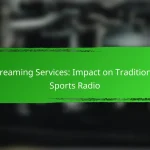What are the current market trends in sports radio in Australia?
The current market trends in sports radio in Australia highlight a significant shift towards digital platforms, increased podcasting popularity, and a strong focus on local content. These trends reflect changing consumer preferences and the evolving media landscape.
Increased digital streaming
Digital streaming has become a dominant force in sports radio, with listeners increasingly opting for online platforms over traditional AM/FM broadcasts. This shift allows for greater accessibility, enabling fans to tune in from anywhere using smartphones or computers.
Major sports radio networks in Australia are investing in their streaming services, offering live broadcasts, on-demand content, and interactive features. This trend is expected to continue as internet connectivity improves and more listeners embrace digital options.
Rise of podcasting
Podcasting has surged in popularity within the sports radio sector, providing fans with a flexible way to consume content. Many sports networks and independent creators are producing podcasts that cover various topics, from game analyses to athlete interviews.
This trend allows for niche content catering to specific interests, attracting dedicated audiences. Advertisers are taking notice, leading to increased sponsorship opportunities and revenue growth in the podcasting space.
Integration of social media
Social media platforms are playing a crucial role in sports radio by enhancing listener engagement and interaction. Broadcasters are using platforms like Twitter, Facebook, and Instagram to share live updates, promote shows, and connect with fans.
This integration not only boosts listener loyalty but also creates opportunities for real-time discussions during games and events. Sports radio shows that effectively leverage social media can significantly expand their reach and influence.
Focus on local content
There is a growing emphasis on local content in Australian sports radio, as audiences seek coverage that resonates with their communities. Local stations are prioritizing discussions around regional teams, events, and issues that matter to their listeners.
This trend fosters a sense of connection and loyalty among fans, as they feel more engaged with content that reflects their local sports culture. Advertisers are also recognizing the value of targeting local audiences, leading to tailored marketing strategies.
Growth of sports betting discussions
The rise of sports betting in Australia has led to an increased focus on betting discussions within sports radio. Many programs now incorporate betting insights, tips, and analyses as part of their regular content, catering to the growing interest in wagering among fans.
This trend not only attracts a new audience but also opens up additional revenue streams through partnerships with betting companies. However, broadcasters must navigate regulations surrounding gambling content to ensure compliance and responsible messaging.
How are advertising strategies evolving in sports radio?
Advertising strategies in sports radio are increasingly focusing on digital platforms and data-driven approaches. This evolution allows advertisers to reach specific audiences more effectively and measure the impact of their campaigns in real-time.
Targeted digital advertising
Targeted digital advertising leverages data analytics to deliver personalized ads to specific demographics. By understanding listener preferences and behaviors, sports radio stations can create tailored ad experiences that resonate with their audience.
For example, a station may use listener data to promote local sports events to fans of a particular team, increasing engagement and conversion rates. Advertisers benefit from higher ROI as their messages reach the right people at the right time.
Programmatic ad buying
Programmatic ad buying automates the purchasing of ad space through technology, allowing for real-time bidding and placement. This method streamlines the ad buying process, making it faster and more efficient for both advertisers and stations.
By using programmatic platforms, advertisers can adjust their campaigns on-the-fly based on performance metrics, ensuring their ads remain relevant. This flexibility is crucial in the fast-paced sports environment, where audience interests can shift rapidly.
Partnerships with sports teams
Partnerships with sports teams enhance the credibility and reach of sports radio advertising. By collaborating with teams, stations can create unique promotional opportunities that engage fans directly.
For instance, a sports radio station might sponsor a local team’s events or broadcasts, providing exclusive content and promotions. These partnerships not only boost visibility but also foster a sense of community, making listeners more likely to support the advertisers involved.
What are the key demographics for sports radio listeners?
The key demographics for sports radio listeners primarily include younger audiences, predominantly males, and a mix of urban and rural residents. Understanding these demographics helps advertisers and broadcasters tailor their content and marketing strategies effectively.
Age groups 18-34
Listeners aged 18-34 represent a significant portion of the sports radio audience. This age group is often attracted to dynamic content, including live sports commentary and interactive segments. Engaging this demographic requires a focus on current trends and popular sports personalities.
To capture the attention of younger listeners, sports radio stations can incorporate social media interactions, live polls, and discussions on trending topics. This approach not only enhances listener engagement but also encourages sharing and word-of-mouth promotion.
Male listeners predominance
Sports radio has a notable predominance of male listeners, often comprising around 70-80% of the audience. This trend reflects broader interests in sports culture, where men are typically more engaged with live events and sports talk shows. Advertisers often target this demographic with products and services aligned with male interests.
To effectively reach male listeners, sports radio stations should focus on content that resonates with their interests, such as in-depth analysis, interviews with athletes, and coverage of major sporting events. Tailoring advertisements to appeal to this audience can enhance engagement and drive sales.
Urban vs rural listener distribution
The distribution of sports radio listeners varies between urban and rural areas, with urban listeners generally making up a larger share. Urban audiences often have access to a wider variety of sports programming and events, contributing to higher engagement levels. Rural listeners, while fewer, may have strong loyalty to local teams and events.
To cater to both demographics, sports radio stations should balance national coverage with local sports news. This strategy ensures that urban listeners stay informed about broader sports narratives while rural audiences feel connected to their local teams and events. Engaging both segments can enhance overall listenership and community involvement.
How does sports radio compare to other media in Australia?
Sports radio in Australia offers a unique blend of immediacy and accessibility that distinguishes it from other media formats. While it attracts a dedicated audience, its reach and engagement levels can vary significantly compared to sports television and online content.
Comparison with sports television
Sports television typically provides a more visual experience, showcasing live events and highlights that engage viewers through rich imagery and commentary. In contrast, sports radio relies on audio storytelling, which can create a more intimate connection with listeners but lacks the visual elements that many fans enjoy.
In Australia, sports television often dominates in terms of viewership numbers, especially during major events like the AFL Grand Final or the NRL Grand Final. However, sports radio remains popular for its convenience, allowing fans to tune in while commuting or working, which can lead to a loyal listener base.
Comparison with online sports content
Online sports content encompasses a wide range of formats, including articles, videos, and social media updates, providing fans with instant access to information and highlights. While sports radio offers live commentary and analysis, online platforms allow for interactive engagement and multimedia experiences that can attract younger audiences.
In Australia, the rise of digital platforms has shifted some audience attention away from traditional media like sports radio. However, radio still holds an advantage in delivering real-time updates and discussions, making it a valuable resource for fans who prefer auditory content over reading or watching.
What technologies are shaping the future of sports radio?
Technologies such as artificial intelligence and smart speaker integration are significantly influencing the evolution of sports radio. These advancements enhance content delivery, improve user engagement, and offer personalized listening experiences.
Artificial intelligence in content curation
Artificial intelligence (AI) is transforming content curation in sports radio by analyzing listener preferences and behaviors. AI algorithms can recommend shows, segments, or highlights tailored to individual tastes, increasing listener retention and satisfaction.
For instance, AI can track which sports events or topics generate the most interest among audiences, allowing stations to adjust their programming accordingly. This data-driven approach helps broadcasters stay relevant and competitive in a crowded market.
Smart speaker integration
Smart speakers are becoming a vital platform for sports radio, enabling hands-free access to live broadcasts and on-demand content. Users can easily request specific games, updates, or sports news using voice commands, making it convenient to stay informed while multitasking.
Integrating with smart speakers also allows sports radio stations to reach a broader audience. Stations should ensure their content is optimized for voice search and consider creating interactive features, such as live polls or trivia, to engage listeners further.
What are the challenges facing sports radio in Australia?
Sports radio in Australia faces several challenges, primarily due to the rise of digital platforms and changing listener preferences. Traditional radio must adapt to maintain relevance in a rapidly evolving media landscape.
Competition from digital platforms
Digital platforms have significantly transformed the sports radio landscape in Australia. Streaming services, podcasts, and social media offer listeners on-demand content that traditional radio struggles to match.
Listeners now prefer the flexibility of accessing sports content anytime and anywhere, which has led to a decline in live radio audiences. For instance, many sports fans turn to podcasts for in-depth analysis or highlights, making it essential for sports radio to innovate and provide unique live experiences.
To compete effectively, sports radio stations should consider integrating digital strategies, such as offering live streaming, interactive content, and engaging with audiences on social media. This approach can help retain current listeners and attract new ones, ensuring that sports radio remains a viable option in the digital age.











